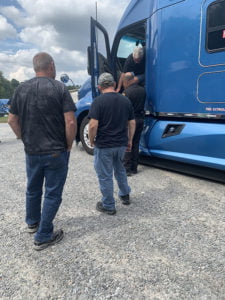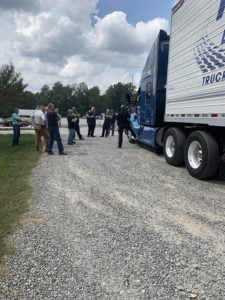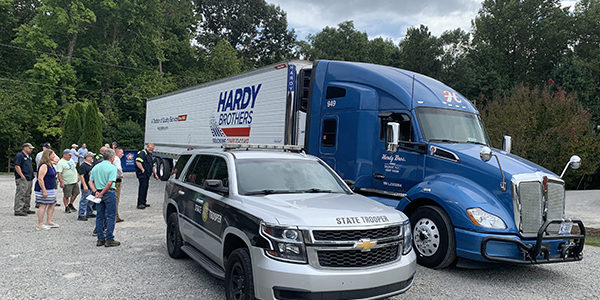Because Safety Matters
At Hardy Brothers, we take safety seriously…very seriously. Our laser-like focus on safety means our drivers return home to their families while keeping those we share the road with safe as well.
One of the ways we work to achieve our high safety standard is by holding quarterly Executive Safety Committee meetings that include drivers, technicians, and key office personnel. These meetings provide action to support our Safety Mission Statement.
During our Sept. 2021 meeting, we had a hands-on demonstration from a North Carolina State Trooper who did walk-thru simulations of different safety inspections that drivers can expect throughout the country if they are pulled over to have a roadside inspection done.
There are three different levels of inspections that the Department Of Transportation (DOT) officers may conduct:
LEVEL 1
The North American Standard’s most comprehensive inspections include a thorough inspection of both the vehicle  and driver. Drivers can expect the inspector to check all documents and undergo a search for things like alcohol, drugs, and hazardous materials.
and driver. Drivers can expect the inspector to check all documents and undergo a search for things like alcohol, drugs, and hazardous materials.
Drivers should have the following documents on hand: Driver’s license; daily driver’s log and Hours of Service records; and Driver and Vehicle Inspection Report (DVIR)
The following vehicle parts may get inspected: Seatbelt; brake systems and tires; coupling devices; exhaust system and fuel system; emergency exits and/or electrical cables; frame; headlamps, stop lamps, brake lamps, and tail lamps; safe loading; securement of cargo; steering mechanism; suspension; turn signals; wheels, rims, and hubcaps; windshield wipers.
LEVEL 2
The only major difference between a Level I inspection and a Walk-Around Driver/Vehicle Inspection is that a DOT inspector conducting this type of inspection will check only those items that can be inspected without physically getting under the vehicle. This means the Level II inspection is typically less exhaustive than the Level I, but vehicles should still be in good shape, and drivers should ensure all documents are in order.
conducting this type of inspection will check only those items that can be inspected without physically getting under the vehicle. This means the Level II inspection is typically less exhaustive than the Level I, but vehicles should still be in good shape, and drivers should ensure all documents are in order.
LEVEL 3
This level of inspection, also known as a “driver-only” inspection, focuses solely on a driver’s credentials and may include a thorough inspection of the following: Record of Duty Status (RODS); driver’s license; HAZMAT requirements; medical card and waiver; Vehicle Inspection Report; HOS documentation; seat belt; and alcohol or drug use.
While most drivers have been through an inspection at least once on the road, it was still a great way to dig deeper into the questions of why troopers do things a certain way, what troopers may be looking for. It provided the drivers a chance to go through the steps of any of the inspection processes.

